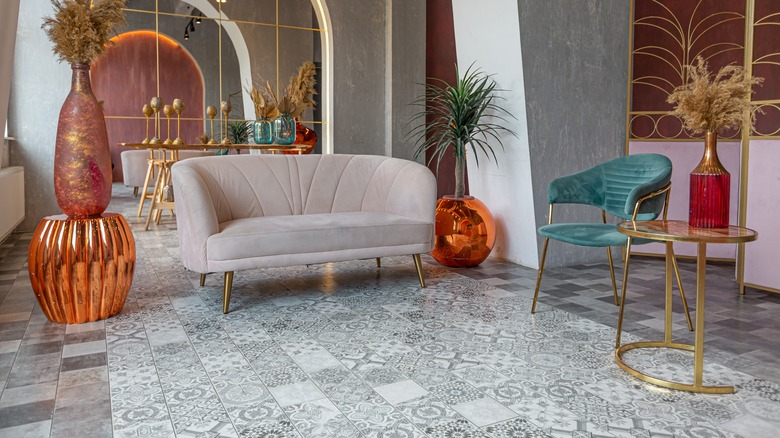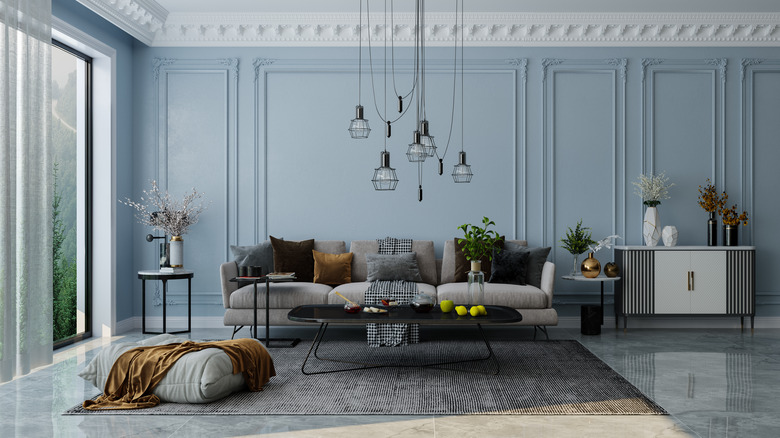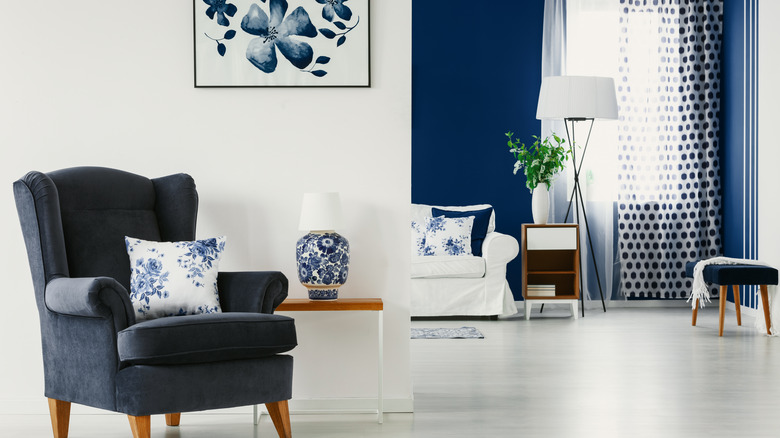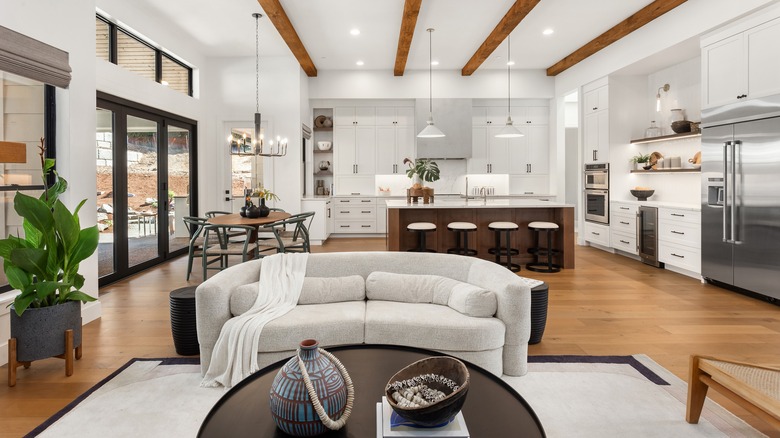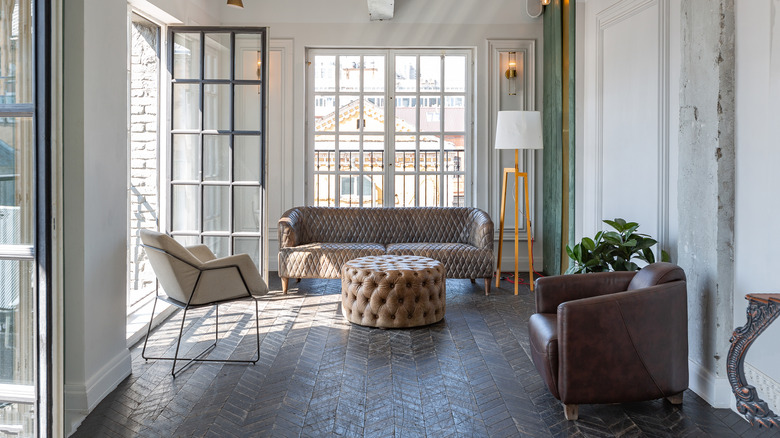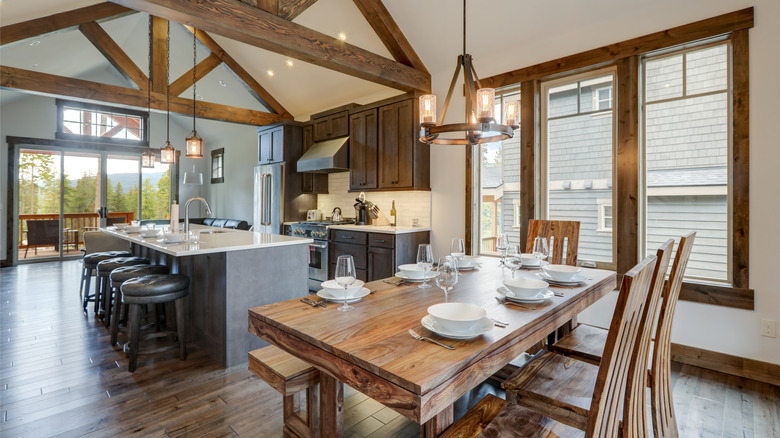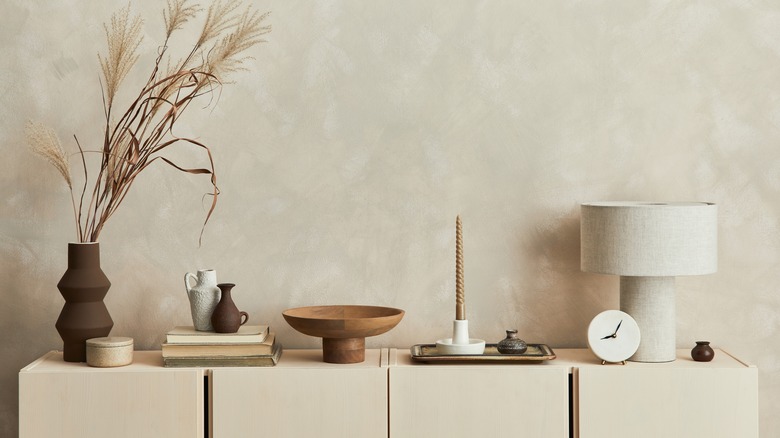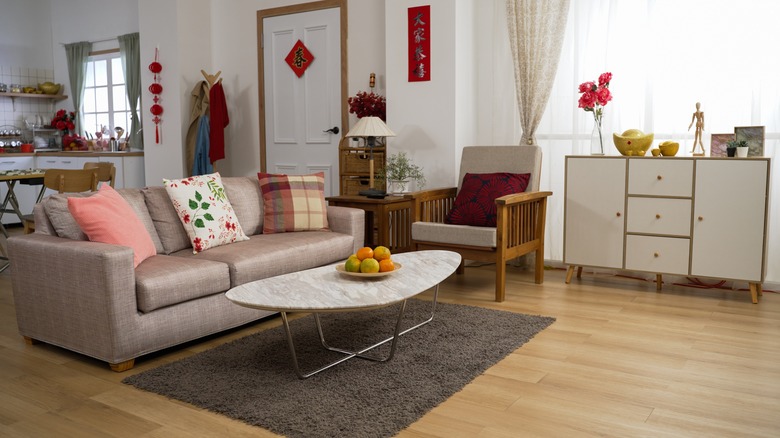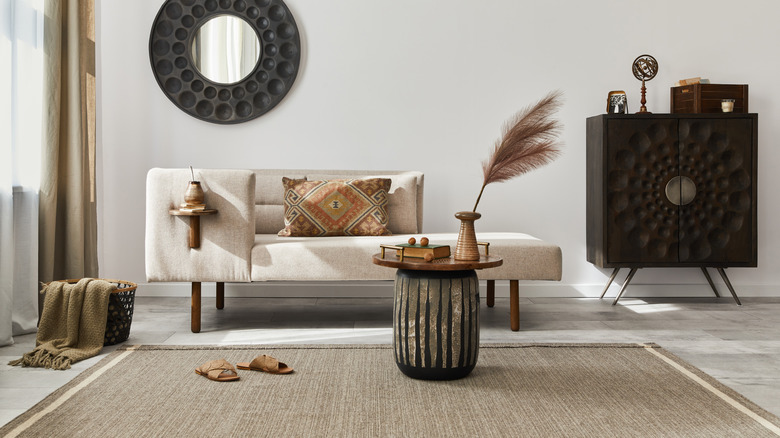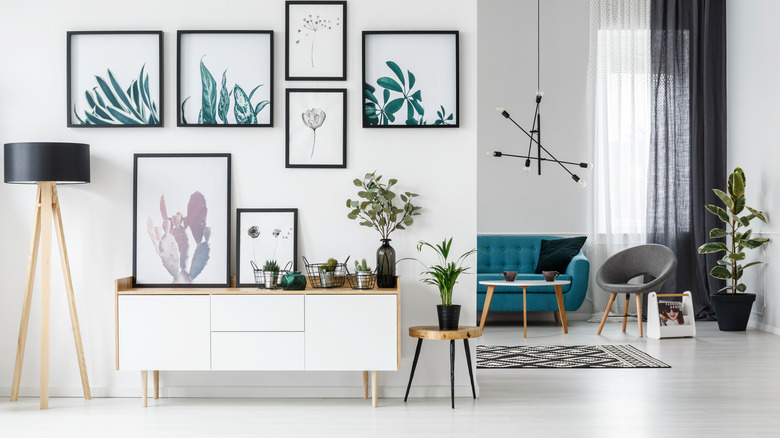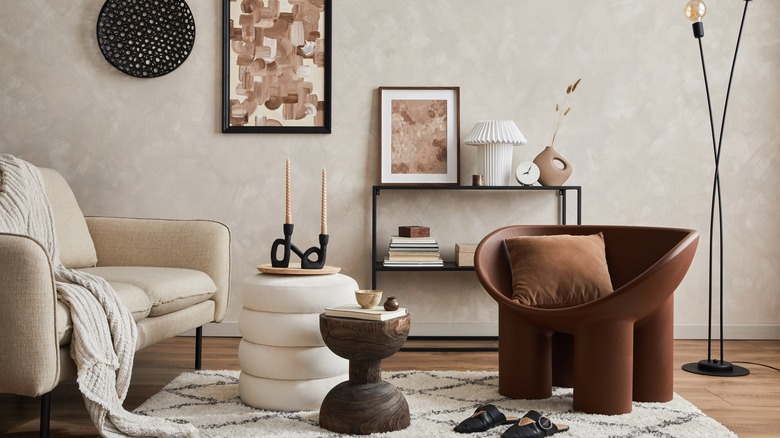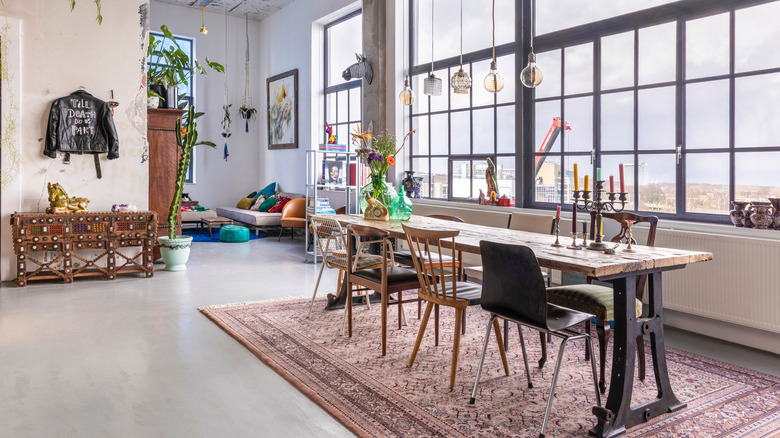How To Decorate Your Interior With A Mixture Of Styles
Ever wonder what your interior design style is? Perhaps you love the curved sofas of contemporary interiors, ornate features in vintage homes, or you may even admire a mid-century modern accent chair with distinct legs. The best aspect of interior decorating is that you don't have to choose just one style. "Blending pieces from different periods and provenances makes a home more interesting," interior designer Nina Farmer told Vogue. Decorate your space just how you like with inspiration from the interior styles you love the most, all under one roof.
Mixing interior design styles without professional knowledge can be challenging, but it doesn't have to be. To achieve a tasteful, cohesive design with multiple styles in your home, find the right balance between space, texture, fabrics, colors, and furniture. Don't be afraid to let your creativity flow Harmoniously mix a medley of interior preferences together from classic to modern, rustic, boho, mid-century, or any variation of traditional decor in one place with pointers you'll find right here. After all, displaying your favorite decorative objects makes a house feel more like a home. Decorate your interior with confidence by using the following tips and tricks.
Put together a limited color palette
Achieving a harmonious blend of multiple styles in an interior requires a limited color palette. Now you may think that sounds boring, but you would be wrong. An interior, especially one with multiple styles, looks best with a neutral background. Neutral colors literally go with everything and are certainly not bland. They are layered with depths of color when done correctly. Creating an interior color palette around a limited number of neutral tones can be tricky if you cannot tell the difference between cool and warm colors. "This is basically the difference between beige tones (warm) and grey tones (cool)," designer Jessi Eve told TLC Interiors. "I personally love a blend of the two ('greige') as the right shade can read as either cool or warm depending on which other tones are placed alongside it. It's certainly not "against the rules" to mix warm and cool tones but it does require a good eye to ensure tonal balance and cohesion." When mixing multiple design preferences under one roof, adhere to a warm or cool foundation. This tip will help you combine styles easily without competing with a contrasting background.
Neutral colors are a part of most if not all interior styles, from contemporary to rustic through industrial to mid-century modern, making them an easy choice for a foundation of color in a home representing multiple styles. The best part about using neutrals in home decor is adding punches of color whenever you want, from farmhouse plaid to pops of bright pink for an Art Deco vibe. When decorating in multiple styles, try to find homogenous accent colors across the designs and keep the tones consistent with the existing palette. Unless one of your interior styles is maximalist, decorate with colors sparingly and coordinate them across the styles. Introducing too many colors will make it difficult to unite them all in one space.
Pick a pattern worth repeating
Patterns are one of those interior elements that can cross over between design styles. Pattern mixing is an ideal way to add visual interest to an interior. Add them on more than one scale when decorating with a mix of styles. How do you do that? Repeating patterns in different sizes across the interior helps create a sense of rhythm. "Using and mixing scales is a great way of putting a room together," Charlotte Gaisford told Homes & Gardens. "You really have to avoid mixing large scales together as this will lead to the fabric designs fighting with each other and can lead to design problems. If you use small, medium, large scales, spots, and stripes it will all come together."
Create a high-impact space with scaled patterns that make the room look and feel right. Similar patterns placed in adjacent rooms will unite a mix of styles under one roof by creating a sense of belonging. A striped accent pillow isn't just for a beach house aesthetic. It can be a statement print in a traditional interior decor or used for visual texture in a cottagecore theme. Once you choose patterns for your design, search for objects, furniture, and accessories to help create the desired atmosphere in the space. Pattern repetition should occur across the house on different elements and surfaces, such as a floral pattern on powder room wallpaper and a large striped design on an accent rug in another room. Avoid keeping them all the same. You want the pattern juxtaposition to create a cohesive design.
Deliberately match wood undertones
Decorating with a mixture of styles can be chaotic when the elements layered into the look appear lost rather than intentional. One way to tie together the mix of interior styles in your home is to deliberately decorate your space with various wood tones inspired by the design selections you love the most. "You can — and should — mix wood tones. It adds depth to a room, and after all, a forest has many types of trees, right?" interior designer Christina Kim told MyDomaine. "Start by choosing a main wood tone and one to two supporting tones maximum. Keep things feeling consistent by sticking with all warm wood tones such as walnut and oak, or all cool tones like grey stains and ash. Remember that black or white can go a long way to balance different woods in a room."
It's all about matching the undertones of the wood (via Chris Loves Julia). Yes, even wood materials have different tonalities with cool or warm distinctions and should be repeated at least twice in any given space. Mixing and matching the wood types in an interior will introduce contrast and a curated vibe. Three types of wood are more than sufficient, as decorating with too many tones will negatively impact the appearance. When in doubt, opt for contrast and mix wood types that are opposite.
Remember that antiques get better with age
Mix interior styles like a pro by decorating with pieces that generate a sense of timelessness. "If there is one way to substantially alter and enhance a room, it's with the addition of a piece of antique furniture," Milly Clarke, creative director at Albion Nord, told House & Garden. You can tie together multiple aesthetics together by furnishing a room with antique furniture. Including vintage decor from different periods brings together pieces that are decades apart. You don't want to recreate a room from the past, so display these pieces amongst contemporary items.
Classic pieces only get better with time and can instantly add personality and character to a room. Jump on the trend by upcycling an old dresser or go antiquing for a vintage mirror, vase, or painting. Mix and match antiques from different periods by sourcing items that are the shapes, forms, and colors you need. For example, a traditional writing desk paired with an ergonomic mid-century modern leather desk chair can make an office space feel less like work. Create visual charm in your home by decorating with vintage details from different periods for a cohesive look.
Don't divide the rooms
You may think a room-by-room approach is the best way to decorate with multiple styles and showcase your interests. However, it's the opposite of what you want to do. Dividing rooms into specific themes actually divides the decor rather than brings it together, resulting in a disjointed design. Does that mean all the rooms have to match? Absolutely not, but they should definitely contain similarities and complementary pieces. For instance, you can design a rustic kitchen, contemporary living room, and French country bedroom if you include elements in each space that connect to another.
Connecting spaces does not have to be challenging. "Using simple unconscious devices that link rooms in a home helps people feel comfortable in a space they enjoy," interior designer and architect Peter Sheehan told Homes & Gardens. "And it's not just through colors and patterns; you can use this through textures as well. For example, using seagrass throughout a space — on the walls, using a seagrass carpet and in accessories such as baskets and rugs." Be precise about the elements you want to repeat since what you choose needs to blend with the design in the room.
Use a trio of objects to create balance
When decorating a space with different styles, it's not about grouping decor by category. Instead, it's about finding a way to mingle all the pieces for a complete look. Easily blend a sculptural bust with a vintage vase next to a contemporary lamp on top of a farmhouse-style table by balancing the elements. Balance is in everything from the windows to the walls, and it should be in your interior. How do you balance a design? Use the decor to create a sense of symmetry in your house by layering fixtures that feel right. You can create visual balance in the size, shape, and visual weight of an object no matter the design preference.
Interior style doesn't matter as much as how pieces look on a shelf or tabletop. Create a balanced display by creating a focal point using the rule of three. This tip means that putting three of anything together will appear more pleasing than any other number of textures, materials, small accessories, or furniture pieces (via Hue Maui). Establishing a focal point amongst the decor gives the eye a place to rest when glancing around the room. The other elements have something to anchor to without even noticing if they're mid-century, rustic, traditional, or coastal.
Bridge styles with throw pillows
Pillows can be an interior designer's best friend when decorating a home with many styles. These plush little accents can help bridge the interior preferences with little effort. They're easy to love, practical, and versatile. "Mixing and matching a few different decorative pillows adds layer and texture into rooms," designer Melison St. Claire told Forbes. Mix styles in your space with different colors and patterned throw pillows, as the options are endless.
Throw pillows are available in many styles, shapes, colors, and patterns, making them a perfect decor item for those mixing multiple styles. Pillow patterns don't have to be exclusive to any category, as many compositions can overlap in interior preferences. When decorating with pillows, it's all about the way you style them. Elevate the scheme by creating a vignette you won't want to stop admiring. It's best to stick to odd groupings and vary different sizes. You can have a modern geometric pillow paired with a floral design and toss in a few basic neutrals to help break up the patterns and tie everything together. Update them and swap a few out when you want a new vibe.
Tap into texture
Let your personality shine through the textures in your home. Texture is an impactful interior feature that adds visual character to furnishings and surfaces. "Texture makes all the difference between a room seeming warm and inviting rather than cold, flat, and unfinished," Los Angeles-based interior designer Erica Islas told the Chicago Tribune. "Introduce texture through layering different ones — some tactile, some with dimension, and some reflective." Finding ways to layer various texture elements in a space will give the design depth and help you blend multiple styles.
When decorating with a mixture of styles, consider matte finishes versus glazed, glass, ceramic vases, knitted, tassel, and woven accents. These textural features can be from many interior design styles yet tailored in one room cohesively. Industrial tables with marble tops next to suede sofas with nailhead trim are a whole vibe and a great way to blend a few different interior styles. Use textural elements from the interior aesthetics you love most to differentiate yet relate the decor types. You can always casually style a chunky knit or chevron blanket and leather pouf to tie in your favorite interior forms.
Combine designs with art
Art is an interpretive decorative element that can bring together even the most unlikely style pairings. Curate an art collection with various art pieces inspired by design styles you adore. Choose to position them as solo focal points or grouped in different gallery wall arrangements to increase dimension and help mesh styles. When mixing and matching artwork on your walls, consider color, picture, and scale, as these features will directly affect the visual interest, regardless of a contemporary, abstract, minimalist, rustic, or bohemian style.
For example, you can hang a rustic landscape photo over a contemporary couch or choose an abstract creation in neutral colors to display over a vintage credenza. These tips will help tie together your style decisions. Conceptual art or pieces depicting scenic views are best received as large-scaled pieces, while floral photos with many fine details capture viewers' attention by being grouped on the walls, per E Interiors Design. Stimulate visual diversity in your interior as even the oddest combinations may look better than you think on your walls. Accentuate the walls in your home with art that encompasses colors, shapes, or silhouettes from multiple styles to create a sense of harmony. At the end of the day, the most important thing is to follow your heart and choose pieces that speak to you.
Create unlikely furniture pairings
Combining your favorite objects under one roof can feel overwhelming. A simple way to blend different styles in an interior is by playing with your furniture. Decorating is an evolutionary process that doesn't take place in one day. Over time, you probably accumulate objects from multiple styles, colors, shapes, sizes, and material variations. Don't throw away your old furniture, as the most unlikely pairings may be your best look ever.
For example, you can pair a crescent-style sofa inspired by mid-century, modern, contemporary, or glamorous aesthetics like this one from Wayfair with a set of wingback chairs commonly found in traditional home decor. The unlikely arrangement creates a ton of visual interest in one room without sacrificing functionality or forcing you to choose between styles. Scandinavian furniture, gingham prints, and brass details can create unexpected moments in an interior without feeling like either one is overpowering the other. Unconventional furniture combinations can turn your interior into a beautiful space blending all the interior styles you love.
Adopt a no rules mentality
Throw it all out the window when decorating your place with mixed styles. Let your personality flow without worrying about perfection. Adopt a no-rules approach and let all the sides of your interior shine. "The only real rule in decorating is to buy things that you love," interior designer Lilly Bunn told MyDomaine. If you like it, show it off. The decor in your home doesn't always need to be functional to shine in your place, and it certainly doesn't have to be from the same style family. Stack antique books next to contemporary statues and display cute floral upholstery chairs on top of bohemian floral rugs, even if the colors don't exactly match. If you want to blend a mix of styles, do just that. Embracing a dynamic look in your house will ensure that the home's aesthetic is never dull and flat.
It's entirely possible to style decor from many preferences to create a curated, timeless look that's anything but boring. When decorating a home filled with a mixture of styles, be precise about the placement of objects, materials, color palette, art, textural elements, and furniture. Make a room look appealing and unique by creating an interior style that's unexpected and tailored to your home.
